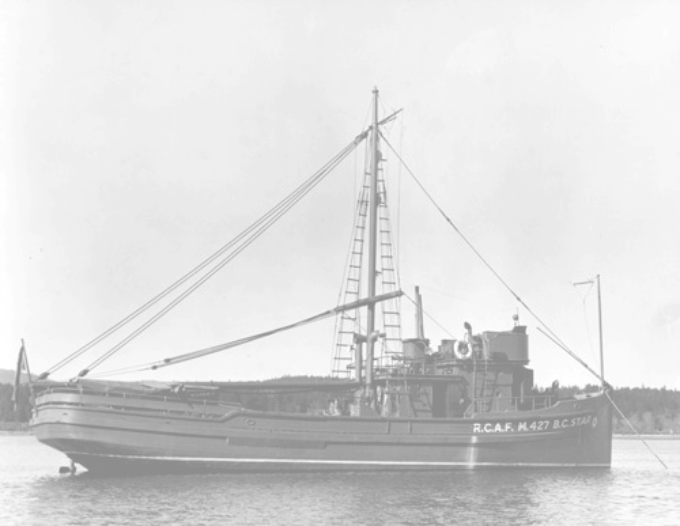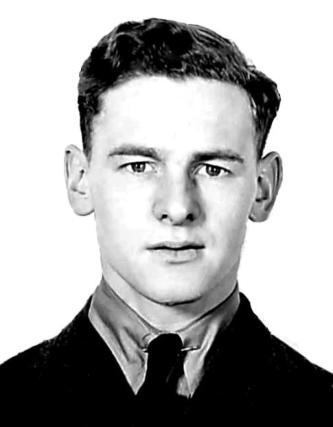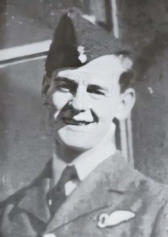
copyright © Wartime Heritage Association
Website hosting courtesy of Register.com - a web.com company
Wartime Heritage
ASSOCIATION
Remembering World War II

William Murray MacNeill
Sergeant
R/124630
Supply and Salvage Ship M427 BC Star
Royal Canadian Air Force
January 27, 1919
Sydney, Cape Breton Co., NS
August 21, 1941
Halifax
Sydney, NS
5 feet, 10½ inches
Fair
Blue
Brown
Single
Machinist Apprentice
Presbyterian
Jean MacNeill (Mother) Sydney, NS
July 24, 1943
24
Ottawa Memorial
Panel 2, Column 5
Commemorated on Page 185 of the Second World War Book of Remembrance
Displayed in the Memorial Chamber of the Peace Tower in Ottawa on April 16
William Murray MacNeill was the son of Hugh Archibald MacNeill (d. 1932) and Jean (Murray) MacNeill
and brother of Donald, Gordon, and Marjorie of Sydney, NS. Donald MacNeill served with the RCAF
overseas during WWII.
William attended school between 1925 and 1938 completing grade eleven. He also completed short
course in blue-prints and machine ship work at night school. He was employed with MacDonalds Ltd., a
wholesale business, as a salesman in 1938 and 1939 and then was employed with Dominion Steel and
Coal Corporation as a machinist apprentice until his enlistment with the RCAF in August 1941.
In November and December 1940 William completed basic military training at No. 61 Canadian Army
Basic Training Centre in New Glasgow, NS.
On enlistment Sergeant MacNeill trained and served in Halifax, Valcartier,
and Ancienne Lorette, Quebec. He received his air gunner badge on
December 7, 1942. He was stationed at RCAF Yarmouth in March, 1943
before being stationed as a trained Wireless Operator (Ground) assigned to
an early warning radar unit in British Columbia.
On July 23, 1943, he was serving as a crew member on the Supply and
Salvage Ship M427 BC Star when it was lost at sea during a supply mission to
Cape St. James in the Queen Charlotte Islands. There were no survivors.
Sergeant MacNeill’s name is inscribed on the Ottawa Memorial.
The Story of M427 “BC Star”
During the build up of the war effort on the West Coast many new remote early warning radar units
were built and maintained. The RCAF requisitioned tugs and fishing craft that were then attached to the
Marine Section to service these otherwise inaccessible stations. These vessels were the “work horses”
that plied back and forth on their unscheduled runs moving construction crews, material, and heavy
equipment up and down the coast of British Columbia. To help keep these radar unit units’ existence
and location secret radio silence was enforced on these runs and all information regarding the
movement of this type of marine vessel was classified and all communications were coded.
On July 23, 1943, M 427 BC Star was scheduled for one of these runs. It departed Bella Bella with a 10
man crew and a cargo of 43 tons of gravel and cement and five No. 9 CMU personnel assigned to the
construction project. They were bound for the new radar site at Cape St. James in the Queen Charlotte
Islands. No. 28 (RU) Cape St James had no way of knowing that the supply boat was on its way as they
had not yet received the necessary cypher equipment to decode the movement message. Radio silence
was enforced on the ship and no one missed her until 3 August when construction crews queried when
their supplies were to arrive.
On August 4 a Stranraer from 9 BR Squadron started the search, on August 5, Norseman #2470 was sent
from Bella Bella to search area and on 8 August a search was carried out by the M.536 SKEENA MAID. An
intense sea and air search covered a wide area during the next several weeks, but only two bodies were
recovered and very little wreckage was found. On September 3 an unidentified airman’s body was found
on Price Island. A tombstone was erected at the Meadow Island Cemetery, Bella Bella, BC to remember
the unknown airman.
Speculation and rumours circulated about the vessel being attacked by a Japanese submarine, and this
information was enhanced by crew members aboard another RCAF Marine vessel inbound to Alliford Bay.
They reported that they were listening to a Ketchikan Alaska radio station when its program was
interrupted by a strange and unidentified transmission “Star out of bread and water. Alliford repeat
message. Thank you. Good Afternoon” However, no conclusive evidence ever came to light that
explained why the Star went down. Evidently the hull had simply opened up under the weight of her
cargo and the M-427 sank so quickly that no life boats were launched and no distress signals were sent.
This supply mission resulted in the largest loss of life in the history of the Marine Branch. The men are
commemorated on panel 2 of the Commonwealth Air Forces Ottawa Memorial dedicated to air force
personnel lost without trace in Canada, the US and neighbouring lands and seas during the Second World
War. One month after the loss, marine craft procedures were revised to ensure prompt reporting of
arrivals and departures.
BC Star crew/passenger list July 23, 1943
R128864 Cpl Charles Gordon Glover
R186865 LAC Harold Fredrick Dakenfold
R173910 LAC George Thornton Stead
R213870 AC1 Titus Vollhoffer
R220368 AC2 Maurice Daniel Onuski
R58625 Sgt Philip Eric Olsen
R87823 LAC Clarence James Sherlock
P4319 FSgt Roy Henry Drouillard
R146033 Sgt Jack Douglas Hearfield
R220720 AC2 Gilbert Campbell McFadyen
R151826 FSgt William Ernest Mitchell
R128695 Sgt Jonathan Charles Slater
R255739 AC2 Arthur Garnet Davies
R124630 Sgt William Murray MacNeill
R56918 Cpl Tadeusz Ledwig Polec
William Murray MacNeill


Name:
Rank:
Service No:
Service:
Date of Birth:
Place of Birth:
Date of Enlistment:
Place of Enlistment:
Age at Enlistment:
Height:
Complexion:
Eye Colour:
Hair Colour:
Marital Status:
Trade:
Religion:
Next of Kin:
Date of Death:
Age at Death:
Memorial:
Reference:




- World War I - Menu
- WWI Stories and Articles
- Photos - Yarmouth Soldiers
- Selection of World War I Songs
- WWI Casualties of Yarmouth, NS
- Those Who Served - Yarmouth, NS
- WWI Casualties Digby Co. NS
- WWI Casualties Shelburne Co. NS
- Merchant Mariners (1915) Yarmouth, NS
- Canadian Forestry Corps - Non Yarmouth Birth/Residence Enlistments
- US Draft Registry - Yarmouth NS Born


- World War II - Menu
- WWII Stories and Articles
- Telegraphist Air Gunners
- WWII Casualties of Nova Scotia
- US Casualties with NS Connection
- Far East/Pacific Casualties with NS Connection
- Merchant Navy Casualties Nova Scotia
- Nova Scotia WWII Casualties Holten Canadian War Cemetery
- D-Day Casualties - Nova Scotia
- CANLOAN Program Casualties - Nova Scotia
- Battle of the Bulge Casualties - Nova Scotia
- WWII Casualties Yarmouth NS
- Yarmouth Casualties - RCAF RAF Canadian Army WWII
- Yarmouth Co., Marriages WWII
- Casualties Non-Born/Residents with Connection to Yarmouth Co., Nova Scotia.
- WWII Casualties Digby Co., NS
- Non-Nova Scotian WWII Casualties Buried in Nova Scotia
- WWII RCAF Casualties Aged 16-18
- Brothers/Sisters Who Served - World War II













